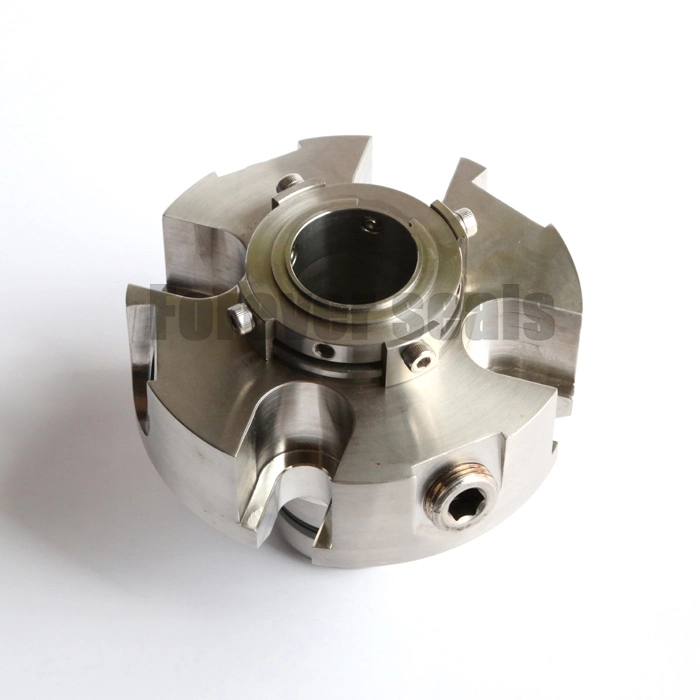Professional O-Ring and Oil Seal Manufacturer, Sealing Solution Supplier Since 2008.
Advanced HSPCT Series Mechanical Seal
Efficient Series - connected Contact Seal for Hazardous Chemical Fluids
The HSPCT series mechanical seal is a specialized series-connected contact seal designed for flammable, explosive, and toxic hazardous chemical fluids, meeting high-risk industrial sealing needs. It adopts a multi-spring, lug-drive, and balanced structure to maintain stable performance under fluctuating pressure and temperature.
Its dual-seal design injects clean buffer fluid between primary and secondary seals, reducing wear and preventing leakage—extending service life to 2–3 years. Needing a matching buffer fluid system, it ensures reliability, cuts maintenance downtime, and boosts safety, serving as a cost-effective choice for chemical, petrochemical, and pharmaceutical sectors.
5.0
design customization
Please fill out the form below to request a quote or to request more information about us. Please be sure to upload customized requirement documents or pictures, and we will get back to you as soon as possible with a response. we're ready to start working on your new project, contact us now to get started.
More Choices
no data
1. Product Advantages
Enhanced Safety: Engineered for hazardous chemical fluids (flammable, explosive, toxic), with a dual-seal structure that forms a secondary leakage barrier, complying with industrial safety standards.
Long Service Life: Multi-spring and balanced design reduces friction; buffer fluid lubrication minimizes wear, extending lifespan to 2–3 years (30% longer than standard single seals).
Stable Performance: Lug-drive mechanism ensures consistent sealing even under fluctuating pressure (0.1–2.5 MPa) and temperature (-20°C to 180°C).
Low Maintenance Cost: Reliable structure cuts unplanned downtime; easy-to-replace components lower long-term maintenance expenses.
2. Working Principle
The HSPCT series is a series-connected contact mechanical seal that operates with two sealing pairs (primary + secondary):
Primary Seal: The main sealing pair (stationary + rotating rings) blocks the majority of hazardous fluid, preventing direct leakage.
Buffer Fluid System: A matching auxiliary system injects clean, low-pressure buffer fluid (e.g., mineral oil) between the primary and secondary seals. This fluid lubricates the primary seal to reduce heat/friction, cools the system, and acts as a barrier against hazardous fluid penetration.
Secondary Seal: The secondary sealing pair captures any residual buffer fluid or minor leaks, ensuring zero hazardous fluid release into the environment.
3. Product Details
The HSPCT series mechanical seal adopts a series-connected contact structure, paired with a reliable lug-drive mechanism to ensure stable power transmission and consistent sealing performance. In terms of spring configuration, it is equipped with 3–6 multi-springs, which evenly distribute pressure across the sealing surface, avoiding uneven wear caused by single-spring pressure concentration. It supports a pressure range of 0.1–2.5 MPa and a temperature range of -20°C to 180°C, adapting to most hazardous chemical processing conditions. For key components, the stationary and rotating rings offer material options of Silicon Carbide (SiC) and Tungsten Carbide—both featuring high hardness and wear resistance—while the sealing gasket is available in Viton or EPDM to meet different chemical corrosion resistance needs. The standard connection size covers DN25 to DN150, and customized sizes can be provided according to specific equipment requirements.
4. Application Range
Ideal for industries handling hazardous chemical fluids, including:
Chemical processing (e.g., acid/base transfer, solvent handling)
Petrochemical (crude oil refining, hydrocarbon processing)
Pharmaceutical (toxic API manufacturing)
Fine chemicals (flammable intermediate production)
Wastewater treatment (hazardous liquid filtration systems)
5. FAQ
Q1: Do I need a specific buffer fluid for the HSPCT seal?
A1: Yes. We recommend mineral oil or glycol-based fluids (viscosity 20–100 cSt at 40°C) to ensure optimal lubrication. Forever Seals provides a buffer fluid selection guide for different applications.
Q2: Can the HSPCT seal be customized for special temperatures/pressures?
A2: Absolutely. We offer custom modifications (e.g., high-temperature-resistant materials for >180°C, reinforced springs for >2.5 MPa) to meet unique client needs.
Q3: How often should the seal be inspected?
A3: For continuous operation, we suggest quarterly visual checks (for leaks, buffer fluid level) and annual component testing.
6. Forever Seals’ Selling Points
15+ Years of Expertise: Specialized in mechanical seals for hazardous industries, with R&D teams dedicated to optimizing safety and durability.
Global Support: 24/7 technical service (via phone/email) and local spare parts warehouses in Asia ensuring fast maintenance.
Certified Quality: All HSPCT seals pass ISO 9001 quality control and meet international standards (API 682, DIN 24960) for hazardous fluid handling.
Customer-Centric Design: We offer free on-site installation guidance and tailor-made solutions based on clients’ specific equipment and fluid types.
{{item.score}} Stars
{{item.pre}}%
{{item.nickname ? (item.nickname.slice(0, 2) + '*****') : item.source === 1 ? 'mall buyer' : '--'}}
{{item.comment_time}}
Review in the {{item.country}}
{{itemAttr.params_key}}: {{itemAttr.params_value}}
Get In Touch With Us
We are committed to meeting the diverse needs of our global customers through innovation and continuous improvement.
Need more information?
If you didn't find what you need, you can send an inquiry through our contact form.
Please fill in the form below.
Quick Links
Products
Contact Us



